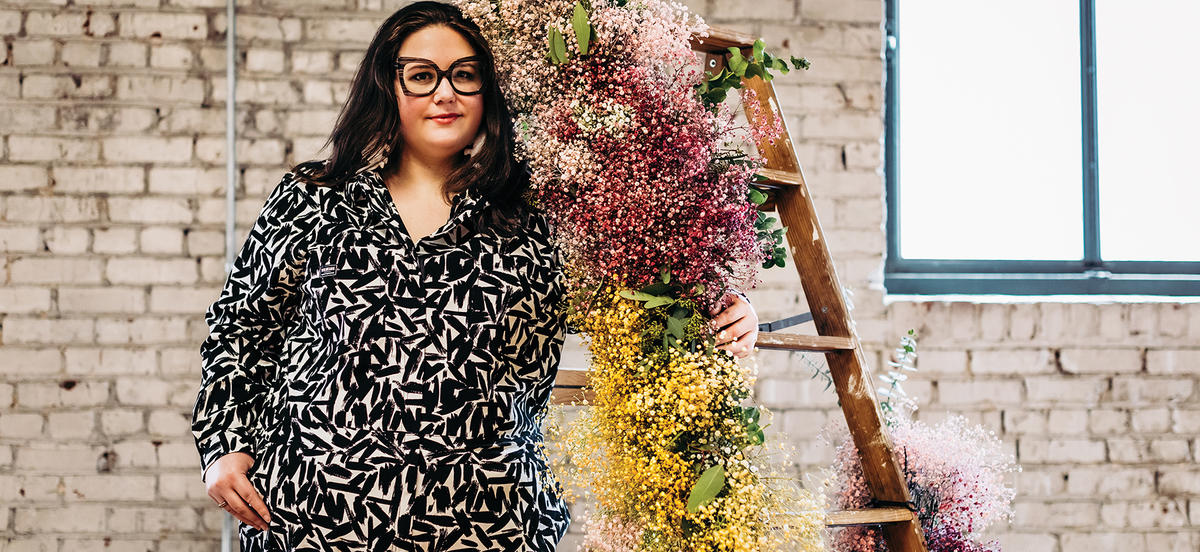Mixed Media: Aubree Penney ’13

Photo by Michelle Evans.
Details
Introduced to art curation while a first-year student at Haverford, Penney now uses art as a vehicle for transformation.
Aubree Penney ’13 is a self-described “fat, disabled, Memphis-raised, Dallas-based curator, artist, and writer” who confronts power dynamics in art and institutional structures through her work. As a project manager and curatorial associate at the Philadelphia-based arts organization Monument Lab, she helps redefine the concept of “public” with projects that prioritize inclusivity and reshape our understanding of art, monuments, and public spaces.
Penney was introduced to art curation at Haverford when she began working at the College’s Cantor Fitzgerald Gallery as a first-year student. She would continue at the gallery throughout college, becoming co-manager during her junior and senior years. She credits Matthew Callinan, associate director of the gallery and campus exhibitions, for fostering her enthusiasm for the field.
“He cultivated a community,” Penney says. “He instilled in students the confidence that we could go into meetings with artists, and he believed we should be there. Without him—and my education in liberal arts—I don’t think I would have been as well-positioned to be as curious as I am, which has been a driving force for me.” When Callinan encouraged the English and religion major to pursue a curatorial career, she listened.
While earning her MFA at the University of London’s Goldsmiths College, Penney curated projects on themes ranging from sex work to the artistry of exhibition labels. For one of her early exhibitions, 2020’s Let Us Love You As You Are, Penney delved into unmet needs within marginalized communities emphasizing queerness, disability, and race, and their interactions with power structures. (The exhibition was slated for the Cantor Fitzgerald Gallery but was turned into a digital event because of the pandemic.) Her curatorial mission, she says, is to create projects in which “people feel witnessed by an object or an artwork, see their own experience amplified, and recognize that it’s allowed to take up space.”
As part of that mission, she maintains an independent curatorial practice, collaborating with Belgian curator Riet Timmerman under the name Call You in the Morning.
At Monument Lab, Penney and her colleagues challenge the conventional view of monuments as static symbols, advocating instead for dynamic representations of history and culture that engage viewers in critical dialogues about the past, present, and future.
The studio’s most recent project, Beyond Granite: Pulling Together, which was on view this past summer on the National Mall in Washington, D.C., is inspired by a 1939 performance by Black opera singer Marian Anderson. Denied access to Constitution Hall due to segregation, Anderson gave a performance on the steps of the Lincoln Memorial.
“What untold stories remain untold on the National Mall?” is the guiding question of the project, whose featured artists presented a series of installations designed to create a more inclusive, equitable, and representative landscape on the National Mall. Their work encompassed Indigenous legacies, the historical context of enslavement, LGBTQ+ activism, and immigration—commemorating these narratives in a very public (and American) space.
“Aubree is a collaborator with superpowers of care and consideration, and grasps how art is a vehicle for transformation,” says Paul Farber, director of Monument Lab and co-curator of Beyond Granite with Salamishah Tillet.
The latest project she has worked on is You’re Welcome, a partnership between artist Cannupa Hanska Luger, Monument Lab, and the University of Michigan (UM) Museum of Art that runs through Feb. 18, 2024. The exhibition explores the complex history of UM’s Alumni Memorial Hall, which was constructed in 1910 to commemorate UM students who served in the Mexican–American, American Civil, and Spanish–American Wars. The exhibition addresses the building’s—and the campus’s—ties to local tribes through a treaty that gifted native land that became the university’s endowment.
Featuring outdoor and indoor installations and an interactive Monument Lab public classroom, the project invites visitors to consider how memory takes shape and, Penney says, “to think critically about what architecture represents and how encoded it is with this all-too-frequent idea of whiteness and culture.”
Getting the opportunity to challenge our notions of what constitutes “public” art and “public” spaces is something she appreciates in her work with Monument Lab.
“The ‘public’ is made up of smaller iterations of publics that are defined by experiences and values and location and community,” Penney says. “Within those, it’s important to maintain sight of individuals. Some projects will resonate with one person and won’t resonate with another, and that’s okay.”
—Lara Ehrlich



